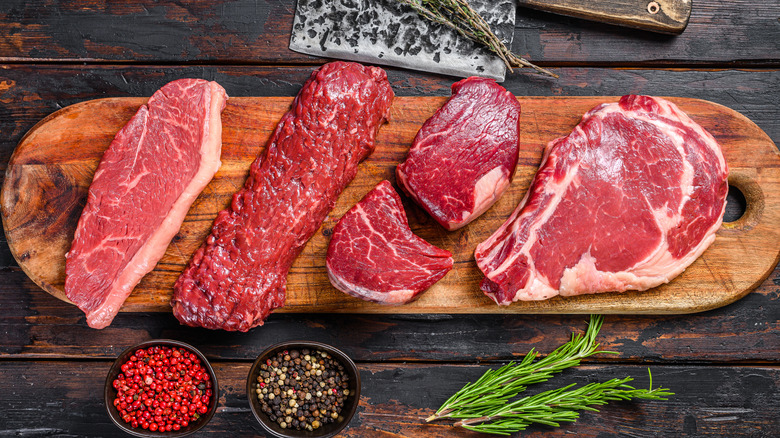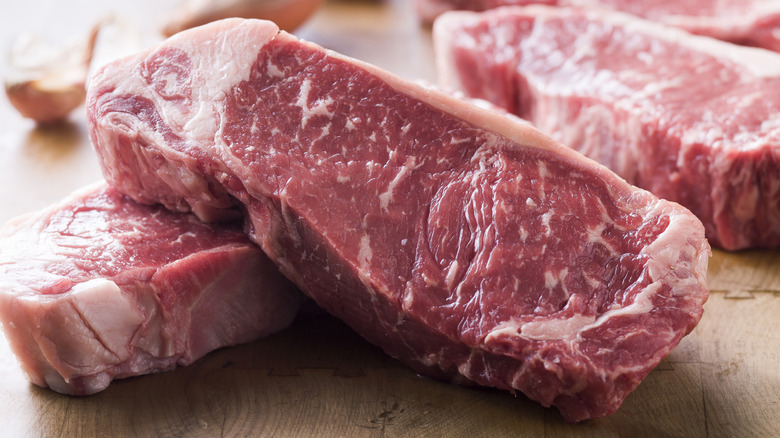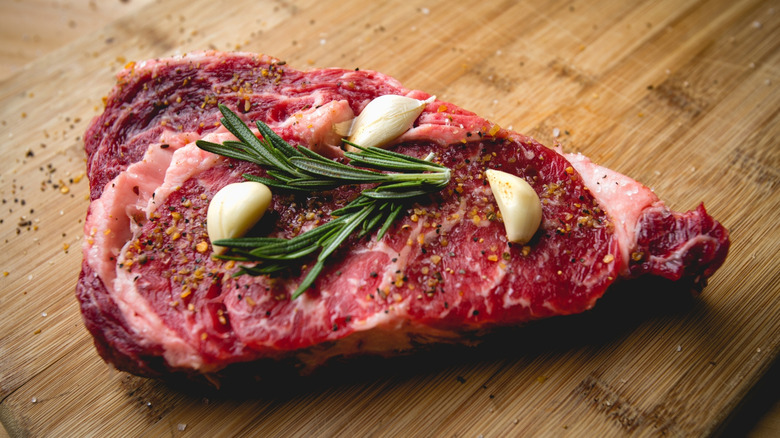New York Strip Vs Ribeye: How Do These Steaks Differ?
Each is a king of beef in their own right, but what is the difference between New York strip and ribeye? The practical differences in taste and cooking requirements between both cuts come down to two elements: fat and location on the cow. Marbled ones, like ribeyes, have more fat, making for juicier, richer meat. Muscles that cows rarely use, like New York strips and ribeyes, are extremely tender as they contain less connective tissue (aka collagen) and have a lush, meaty taste that tougher proteins lack.
Butchers divide a cow into eight different primal cuts, large sections of beef that they process into subprimal cuts, which become individual steaks. For example, the rib section primal breaks down into rib roast subprimal before dividing into individual ribeyes. The short loin primal becomes loins and then New York strips, tenderloins, and T-bones.
All beef is created equally, but that doesn't mean you can treat them the same. Understanding the anatomical differences between New York strips and ribeyes and how these differences play into different cooking best practices is key to getting the most out of both cuts.
The New York strip is leaner but still tender
A strip loin runs from the end of the rib primal to the beginning of the sirloin subprimal. Cows don't use this muscle much, and a gorgeous fat cap tops the whole loin. While the actual meat of a New York strip is comparatively more tender than other lean beef cuts like shanks, it's often tougher than ones with high levels of marbling like ribeyes.
Since it's so lean, New York strips love hot and fast cooking temperatures. If you like your steaks on the rarer side, these cuts are for you as they are exceptional when seared. Slicing against the grain ensures that they remain tender, even if you like them more well done. They are remarkably beefy, with a full, powerful flavor that only needs a little salt and pepper to shine.
For those who love the char of grilled meat, Chef CJ Jacobson, of the Aba restaurant in Miami, calls this the absolute best cut of steak to grill. Fire from the grill bubbles the fat cap perfectly to make it a streak of richness in an otherwise lean protein. If you prefer to cook your meat in a pan, a little bit of butter adds an extra dose of decadence that pairs well with the lush taste of a New York strip.
The ribeye is versatile and buttery
The rib primal cut has tons of intramuscular fat, tender meat, and thick bones that may or may not be included with individual steaks. Cows rarely use their rib muscles, so ribeyes are extremely tender with beautiful marbling. They barely require chewing to melt in your mouth, so you can cook them to any desired level of doneness.
However, the high-fat content of ribeyes means they cause flare-ups when cooked over an open flame. Dustin Green, Head Grill Master and Director of Weber Grill Academy, says they are one of the best steak cuts to reverse sear – where they're brought to temperature in the oven before getting a crust in a hot pan. When cooked properly, their meat stays tender, and their marbling is as soft as butter. They taste significantly richer than New York strips, but their flavor comes primarily from fat rather than lean, compact meat.
Sean Thompson, the executive chef at Porter House Bar and Grill, names the ribeye as the best cut to order at a steakhouse. If prepared perfectly, thin streaks of intramuscular fat melt into the meat, and pockets of marbling crisp to perfection. Knowing how to balance the cooking requirements of marbling and beef may be tricky, but it creates one of the juiciest, most flavorful cuts available.



